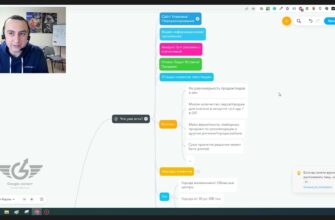- Stages of setting up Performance Max on PrestaShop
- Stages of creating and configuring Merchant Center
- Creating a Merchant Center
- Initial settings of Merchant Center
- Filling in the shipping information
- Options for adding products to the Merchant Center
- Adding product attributes with the Google Shopping Flux plugin
- Checking the results of unloading goods by the system
- Results and conclusions
Hello, everyone. My name is Yana and I’m a Google logistician. I am engaged in delivering the target audience of a business with the necessary parameters using Google advertising tools. And in today’s video, I’ll show you how to set up smart Performance Max Google Ads campaigns on the PrestaShop platform from scratch, from start to finish. I will talk about one of the most budget-friendly options you can have. We will do it all in stages. I remind you that the timecodes will be at the bottom and I think that most likely the parts will also be published as separate videos for the convenience of finding the information you need on your part.
Stages of setting up Performance Max on PrestaShop
So, what do we need to set up our Performance Max on PrestaShop? We need to go through three stages. The first stage is setting up Merchant Center and passing moderation in it. It is one of the longest, because it will take an average of 72 hours for Google to verify our store and our products in this service. The second is setting up analytics for Performance Max to work. And the third is the creation of advertising campaigns. This can all be done on the first day. You can do them in parallel. The only thing you should do is wait until you are moderated in the Merchant Center before creating an advertising account. I would recommend that you do so. So where do we start?
Stages of creating and configuring Merchant Center
We will start with you with Merchant Center. There are several steps to setting up Merchant Center. The first step is to create a Merchant Center account. The second is to set up settings in it about your store. This is a must. The third is setting up shipping information or setting up tax information if you’re launching in the US. And the fourth is adding products to our Merchant Center. That is, adding products to the Merchant Center. Oh, and I forgot an important stage – confirming the rights to our site. Now we will go through all these stages one by one.
How many calls and sales will I get by ordering contextual advertising from you?
I need to calculate the conversion of my website Describe
the task
in the application
Calculate potential ad revenue Google
contextual advertising calculator
Creating a Merchant Center
In order to create a Merchant Center account, you need to follow the link I’ll leave below. What do we need to do?

Directly log in to our Gmail account, which you should have. Mine looks a bit like this because I had several Merchant Centers under one email, but it doesn’t change the essence. What do you need to do? Click “Create a new Merchant Center”.

Next, enter all the information that we will be asked for. This is the registration stage of our Merchant Center.

Do we sell goods online. After that, take our link to our website. Paste it in. I don’t have a physical store. I click “Continue”. Be sure to click “Continue”.

You can check these boxes. You don’t have to. It’s here at your request. Let’s continue. Click “Get started” and we will go through all these stages. I’m not going to dwell on them too much, because you’ll be implementing them directly. I’m going to skip them in order to shorten the length of this video. What are we doing?
Initial settings of Merchant Center
Add a business address. Click Add and here you need to enter the address that you have duplicated on your website either in the footer or directly on the Contact Us page. This address must be the same as the one you have on your website. This is a must.

Same thing… That is, we have now created a Merchant Center account. Next, we need to set up certain mandatory parameters that Google will ask us to set up. You can see how I have Google Merchant Center Next. You can create just a Google Merchant Center. For now, they just have different blocks, different places where the settings are located, but, in principle, they are no different. In general, everyone will soon switch to Merchant Center Next, so you don’t have to worry if you suddenly have some old version of the merchant.
What do we need to set up in this Merchant Center? It is desirable that we fill in this entire block, which is offered to us first of all. You start it in accordance with what is described on your website. If some information is missing, it is advisable to duplicate it. This is necessary so that if you suddenly get blocked by Google, this can also be practiced. You can’t get away from it here without it.

Merchant Center is a separate service where our online store is moderated by us. And Google decides whether to allow us to advertise or not. Where do you start? Add a business address. There is nothing complicated here. You set it up in the way you have it directly on your website or in the footer, or in the “About us” or “Contact us” section. There should be nothing complicated here.
You do the same with your phone number. It’s also important that this phone number is displayed somewhere on the website, otherwise there’s no point in it. Sometimes, some merchants do not offer to enter a phone number at all. This is not a mistake either. You just skip this step.
Next, we need to confirm the rights to our website. What does this mean? We need to tell Google that this particular Merchant Center belongs to us. This is, so to speak, a kind of security system to prevent your site from being stolen by someone or driving traffic to some other site.
To do this, what do we do? We take our domain name, you add it here.

Next, we are offered a set of things like this, with the help of which we can check that this is our site. For ShopExpress, the best thing to do is to add, upload an HTML file. This is the easiest option.

How is it done? You need to open FTP access to your site separately. I will show you how it looks on my personal hosting. You can view this in your hosting in a completely different way. It can look completely different. What’s the point?

We need to click on this link. We download a file like this. Then we upload this HTML file to our FTP. It must be on our FTP. It’s not going to be difficult, you can handle it, I’m sure. And then we click on this link. Because I have been recording this video for some time. Maybe it will be approved right away. Just upload the file to FTP. There will be nothing complicated. Next, you just follow the link that Google offers you. And that’s it. You have confirmed rights to the site. You’ll get the hang of it, there’s nothing complicated.

Filling in the shipping information
Next, what do we need to add? It asks us to add shipping information. I would highly recommend filling it out right away. It is not difficult to fill out. You need to choose the country where you want to deliver. I choose the United States. “Continue”.

Importantly, all this information must match what you have on your website. Select the country. Click “Continue”. Next, I choose whether I need to configure this for all or for individual products.

Then, you can use some kind of automatic integration system that will calculate all this. Right? This is where you customize it yourself. I’ll show you how to do it manually.
How can you do it manually? We set the processing time for our orders. For example, I’m processing this until 8pm. You set the time and then configure the processing time of your order, Handling time is the time for which you process the order. You do not deliver. That is, if I process an order before 8 o’clock, and I process all other orders after 8 p.m. the next day, then I leave it as I have it. Well, you leave the days as you have them.

And the delivery is the time of delivery of your goods. So here I enter, for example, it will take me four days. And so I see that Google tells me that the total number will be 1-5 days. If you want to edit it, do it differently. But make sure that all this information is duplicated on your website. Save.

Be sure to match the currency. What should the currency match with? First, the currency in your feed, which we will do now. Second, with the currency of the country you are delivering to. This is mandatory. So pay attention to this.

Next, all you need to do is set the shipping terms if we are manually filling out. For me, it will be free shipping. You choose as you need. I will not dwell on this too much.

Options for adding products to the Merchant Center
Now we need to add products to our Merchant Center. How do we do that? Either go to our Products, which we have, or you can click on this gear and select data sources. Here we can click Add product source and then we can load the products as follows. We can add automatically products that are taken from structured data on the site. You can add them from a file, as we will do. You can add them from a Google document, that is, from Google Sheets. You can add products one by one and you can add them via the API.

Since my option is implemented through a file, I will implement it through a file. How exactly will I implement it? I already have this module installed. If you suddenly need it, it will be displayed like this.

If you need it, write to me or you can find any alternative paid or free one in your area. I show you how it looks like for me.
Adding product attributes with the Google Shopping Flux plugin
What do we need to do in this plugin? We need to customize a certain set of attributes. Let’s move on. For example, description. We have short, meta, and long descriptions. You choose the one that you have in your products, product cards. It’s all up to you.

Shipping Methods. Look, I had “Price fixed” selected for free, which I set up at the previous stage. Therefore, you choose depending on what you need.

Next. Shipping country. I always specify the country in which I will deliver it. I have UK automatically loaded here. I’m changing it to US. This is important.

Next. Shipping countries. I have chosen the United States. If you need to exclude something here, you add it. Shipping costs in several countries, Carriers to exclude. Okay, let’s move on.

How many calls and sales will I get by ordering contextual advertising from you?
I need to calculate the conversion of my website Describe
the task
in the application
Calculate potential ad revenue Google
contextual advertising calculator
Choose images type, medum default. Choose the MPN, please. I don’t have a product price.

Next, Products gender feature. You can also select everything here automatically. I’ll show you how to do this in the product cards as well.

Since I have a clothing store, you can set it right away. Here you choose according to what you have. For example, I choose like this. Material property. I don’t have a pattern. The size property, or composition, is as you need it.

If you need to export a combination of some attributes, you can also include that. I will definitely include this. I included shipping dimensions for myself to show how they will look like. For example, if you don’t want to manually upload these products with/without a brand. And I also want to make sure that this attribute is enabled. If I don’t have a GTIN, I don’t have an MPN.

Out of stock items, I do not include unloading, but this is at your request. I need the quantity, I need the “On sale indication”, I included the “Root of the site”. I don’t need a prefix yet. I make sure to click “Save & export”. It gives a little error here, but that’s because the programmer is correcting it.

And then we will definitely need to correct the product category with you. I would completely erase it. Why? Because, how can I put it, so that Google can define this product category itself, and you don’t make a mistake. Because these product categories need to be identified by numbers.

That is, you download these files and look for these numbers in them. Because that’s how you can get confused or enter them incorrectly. So I also recommend it. You can also edit certain things separately for a specific product item. “Age group” here will always be “Adult”.

Here is an example of this product item. Here, for example, I can select Size and click Update.
You can do the same with other IDs. For example, somehow Clothes is not set correctly. Be sure to change the Category to “Clothes” here as well. It’s also here. Next is “Update”.

You can do the same thing manually, but it’s cheap and easy. See matching Google category, Clothes > Men. Here you can set the Condition. You can do it manually. You can do it for certain things. I’m showing you an example of how to do it. You will do it yourself.
Next, be sure to edit the currency in this file to match the delivery currency. Do you need taxis? For example, I don’t need them. And in the United States, taxis don’t need to be included. But for certain other countries, they can be.

Do I have this whole story? Є.

Next, I make sure to click on this link to see if I’m okay here.

Then I copy this link, go back to my Merchant Center, paste the link I made here.

Here you can edit the schedule for updating this information.

And notice that I have countries set up here. I don’t need the United Kingdom. Therefore, I am unchecking this box. I’m saving it. You have chosen a language. It must match the language you have. And even here, we have only Free listing available for now. So pay attention to this, because we haven’t done any advertising campaigns with you yet. Let’s move on.

Checking the results of unloading goods by the system
Okay, now our task is to wait until the system starts uploading the goods. I will have about 19 products here. See, this is a nuance. After we upload this, it would be advisable to go into the product cards to see if we have any additional problems with any attributes. Because you see, I’ve only corrected some of the information on some of the products, so you can understand it. Oh, I even have 47 updated products here. So you can wait. They will be unloaded in about a minute or so.

I have 47, because I have unloaded this feed several times. Soon I will have goods here. And then what do I do? I go to my goods. They will all be initially unstuffed. Now they will start to be added. They will appear in our Products tabs now. If anything, we can go here to Data sources to see. It’s still being loaded here. Google is taking its time. 23 product items. Let’s go to All Products.

Well, for now, they are there, but they are not yet displayed here. We need to wait and they will appear soon. This is what my product cards look like after a while.

You can go into it and definitely look here. You see, I have the value [Tax] here, for one simple reason, because I did not configure these taxes separately. I need to make sure that I set them up separately.

We can do that a little bit later because I’m doing this universal video, so I’m not sure you need to show that here. Taxis can be enabled automatically here. We can go to Overview.

So, status, where are we? Oh, sales tax and set them like this – Change. I suggest that we auto-insert all of them if you know that in the States in each state, all of these states have a different tax rate.

That’s why I’m showing you here. You see, I already have 47 product items here. This is what they look like. We have raised the rates with you, taxi drivers. They will soon disappear. And you see, here it’s quarreling about the gender that we need to set.

We can set it a little later. And look, Invalid value with Accepted value, we can edit it right away, gender. For example, I don’t know, unisex let our T-shirt be. Apply. This is you can run through your product cards.

And please note that the pending stage will take us quite a long time, somewhere around three business days or 72 hours. That is, before we can look for any mistakes, we need to get approved by Google itself, which takes up to three business days.

Results and conclusions
Basically, what have we done so far? We have created the Merchant Center. We have confirmed the rights to the site. You have entered a business address. You have entered a phone number. We’ve added shipping information with you. You can add a return policy. I do not add it yet, but it is advisable to add it in the future. It adds more points to your Merchant Center from Google. We started shipping because I had a US country and we added products that are currently being moderated.
So far, we have completed the work with the Merchant Center. Next, we will set up conversion goals. And after our Merchant Center is approved, we will link it to the created Google Ads account. And after that, we will be able to create our advertising campaigns.

Here, in Ad campaigns, we are only offered to create this campaign, so let’s move on to the next blocks.

















